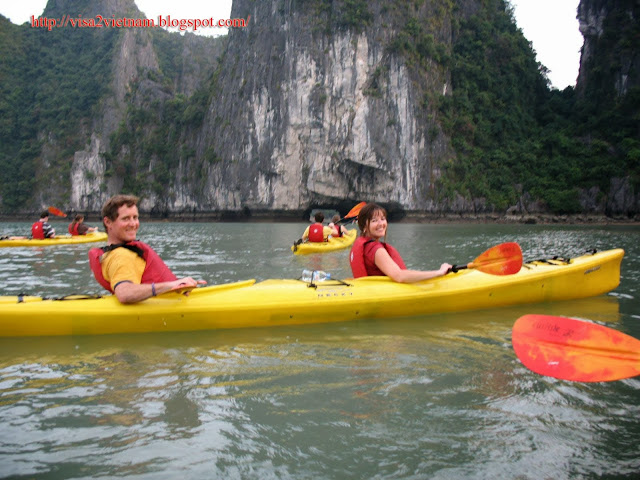Recognized by Unesco as a World Heritage Site since 1994 for
it thousands of natural islands, Ha Long Bay is a legendary world,, and
one of the most magnificent scenic spots in Vietnam as well.
Situated
in North-East of Vietnam (150km
from Hanoi), the Bay is in the Gulf of Tonkin which comprised of regions of
Halong City, the township of Cam Pha, and a part of the island district of Van
Don. It abuts Cat Ba Island in the southwest. Toward the west is the coastline
120km long. The site is 1553 sq.km with 1969 islands of various sizes, of which
989 have been named.
Viewed
from above, Halong Bay resembles a geographic work of art. While exploring the
bay, you feel lost in a legendary world of stone islands. Halong bay is also a
region of highly-concentrated biological diversity with many ecosystems of salt
water-flooded forests, coral reefs, and tropical forests featuring thousands of
species of animal and plant life.
Aesthetic
value
The
permanent beauty of Ha Long is created by three factors: stone, water and sky.
Ha Long’s island system is multicolored with a variety of shapes and can be
regarded as a water-color, a work of art. The islands, scattered all round,
have different shapes which provoke the imagination: Dinh Huong (Incense
Burner) implies spiritual significance, Ga Choi (Fighting Cocks) the symbol of
Viet Nam tourism, Con Coc (Toad) recalls the passage of time, waiting thousands
of years to seek justice in Heaven. There are islands that resemble a
resplendent throne, a Vietnamese mother’s curved back carrying her child, a
roof, an old man, a human head and so on.

Within
the bigger islands are great attractions. Dau Go Cave (Wooden Stakes) dazzles
the senses with many huge stalactites hanging poised in mid air and stalagmites
growing majestically upwards. Then there is Thien Cung Grotto (Heavenly Palace)
with its small, narrow entrance, but inside looking like a marvelous palace,
and many other caves each has its own attractions and beauty.
Ha Long’s
sea is always the same, blue, smooth and still. Ha Long has its own beauty by
seasons. In Spring, buds of trees burst on limestone islands. In Summer, it is
cool and clean with many sparkling sun rays reflecting from the sea’s surface.
In Autumn, especially at night, moonlight illuminates the mountains so they
appear like gold, inlaid into the earth. In Winter, with pervasive frost, Ha
Long is glamorous as “a floating flower basket on smooth wave” (by writer
Nguyen Tuan).
Karst
geomorphologic value:
Ha Long Bay is a mature karst
landscape developed during a warm, wet, tropical climate. The sequence of
stages in the evolution of a karst landscape over a period of 20 million years
requires a combination of several distinct elements including massive thickness
of limestone, a hot wet climate and slow overall tectonic uplift.
The bio diversity value
Bio-diversity
is an important natural resource and needs to be preserved and conserved to
maintain the ecological balance of the whole region. Bio-diversity is the
general term used to reflect diversify and abundance in nature and includes all
living things.
The total
number of plant species living on the rugged islands in Ha Long Bay is still
not known, as many islands remain unexplored. There are probably over a
thousand species of plants, the distribution of which is not uniform. Instead,
several different communities (species of plants that always grow together) are
found, such as: mangrove, seashore plants, those of the slopes or sheer cliffs,
the summit plants and those that grow around the mouth of caves and in gullies.
In 2002 a
survey on assessing and auditing Ha Long Bay’s bio-diversity was conducted by
management authorities and researchers. They surveyed 9 areas in Zone 1 of the
World Heritage and all sites had maintained its bio-diversity and species
diversity, and more new species were discovered.
Evaluation and Praises
Throughout
the ages many famous men, from both home and abroad, when faced with the beauty
of Halong’s sky and water have sung its praises in different ways, especially
in poems.
In the
15th Century, Nguyen Trai (1380 – 1442), a great national poet
visited Halong and spoke of:
“The way
to Van Do has so many mountains
Nature
has produced a wonder in the immense space
The vast
blue sea looks like a grandiose mirror
Reflecting
innumerable black mountains”.
Over 100
years ago, the French Journalist John Rey praised Ha Long: “ In the
brilliant light of the tropical sun, the sea surface, dark and light, here and
there in the shadow of limestone mountains, is really an indescribable,
fanciful scene. Sunset looks like a flaring fire, throwing all the islands into
a fairyland.”
Nowadays,
many domestic and international politicians, poets, cultural celebrities and
tourists make the same comment when they visit Halong Bay: “If you
haven’t visited Ha Long Bay, you haven’t been to Viet Nam.”
In recent
years, Halong Bay has been honored to welcome many international delegations,
including the leaders of many countries of the world.














.jpg)

